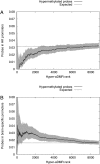Human aging-associated DNA hypermethylation occurs preferentially at bivalent chromatin domains
- PMID: 20219945
- PMCID: PMC2847746
- DOI: 10.1101/gr.103101.109
Human aging-associated DNA hypermethylation occurs preferentially at bivalent chromatin domains
Abstract
There is a growing realization that some aging-associated phenotypes/diseases have an epigenetic basis. Here, we report the first genome-scale study of epigenomic dynamics during normal human aging. We identify aging-associated differentially methylated regions (aDMRs) in whole blood in a discovery cohort, and then replicate these aDMRs in sorted CD4(+) T-cells and CD14(+) monocytes in an independent cohort, suggesting that aDMRs occur in precursor haematopoietic cells. Further replication of the aDMRs in buccal cells, representing a tissue that originates from a different germ layer compared with blood, demonstrates that the aDMR signature is a multitissue phenomenon. Moreover, we demonstrate that aging-associated DNA hypermethylation occurs predominantly at bivalent chromatin domain promoters. This same category of promoters, associated with key developmental genes, is frequently hypermethylated in cancers and in vitro cell culture, pointing to a novel mechanistic link between aberrant hypermethylation in cancer, aging, and cell culture.
Figures






Similar articles
-
Polycomb repressive complex 2 epigenomic signature defines age-associated hypermethylation and gene expression changes.Epigenetics. 2015;10(6):484-95. doi: 10.1080/15592294.2015.1040619. Epub 2015 Apr 16. Epigenetics. 2015. PMID: 25880792 Free PMC article.
-
Changes of bivalent chromatin coincide with increased expression of developmental genes in cancer.Sci Rep. 2016 Nov 23;6:37393. doi: 10.1038/srep37393. Sci Rep. 2016. PMID: 27876760 Free PMC article.
-
An annotated list of bivalent chromatin regions in human ES cells: a new tool for cancer epigenetic research.Oncotarget. 2017 Jan 17;8(3):4110-4124. doi: 10.18632/oncotarget.13746. Oncotarget. 2017. PMID: 27926531 Free PMC article.
-
Poised chromatin in the mammalian germ line.Development. 2014 Oct;141(19):3619-26. doi: 10.1242/dev.113027. Development. 2014. PMID: 25249456 Free PMC article. Review.
-
DNA methylation in health, disease, and cancer.Curr Mol Med. 2007 Feb;7(1):85-102. doi: 10.2174/156652407779940413. Curr Mol Med. 2007. PMID: 17311535 Review.
Cited by
-
Identifying the genomic determinants of aging and longevity in human population studies: progress and challenges.Bioessays. 2013 Apr;35(4):386-96. doi: 10.1002/bies.201200148. Epub 2013 Feb 19. Bioessays. 2013. PMID: 23423909 Free PMC article.
-
DNA methylation and chromatin accessibility predict age in the domestic dog.Aging Cell. 2024 Apr;23(4):e14079. doi: 10.1111/acel.14079. Epub 2024 Jan 23. Aging Cell. 2024. PMID: 38263575 Free PMC article.
-
Age-related differences in monocyte DNA methylation and immune function in healthy Kenyan adults and children.Immun Ageing. 2021 Mar 8;18(1):11. doi: 10.1186/s12979-021-00223-2. Immun Ageing. 2021. PMID: 33685492 Free PMC article.
-
Differential methylation in glucoregulatory genes of offspring born before vs. after maternal gastrointestinal bypass surgery.Proc Natl Acad Sci U S A. 2013 Jul 9;110(28):11439-44. doi: 10.1073/pnas.1216959110. Epub 2013 May 28. Proc Natl Acad Sci U S A. 2013. PMID: 23716672 Free PMC article.
-
The dynamics and prognostic potential of DNA methylation changes at stem cell gene loci in women's cancer.PLoS Genet. 2012 Feb;8(2):e1002517. doi: 10.1371/journal.pgen.1002517. Epub 2012 Feb 9. PLoS Genet. 2012. PMID: 22346766 Free PMC article.
References
-
- Azuara V, Perry P, Sauer S, Spivakov M, Jørgensen HF, John RM, Gouti M, Casanova M, Warnes G, Merkenschlager M, et al. Chromatin signatures of pluripotent cell lines. Nat Cell Biol. 2006;8:532–538. - PubMed
-
- Barski A, Cuddapah S, Cui K, Roh TY, Schones DE, Wang Z, Wei G, Chepelev I, Zhao K. High-resolution profiling of histone methylations in the human genome. Cell. 2007;129:823–837. - PubMed
-
- Bernstein BE, Mikkelsen TS, Xie X, Kamal M, Huebert DJ, Cuff J, Fry B, Meissner A, Wernig M, Plath K, et al. A bivalent chromatin structure marks key developmental genes in embryonic stem cells. Cell. 2006;125:315–326. - PubMed
-
- Bibikova M, Le J, Barnes R, Saedinia-Melnyk S, Zhou L, Shen R, Gunderson KL. Genome-wide DNA methylation profiling using Infinium® assay. Epigenomics. 2009;1:177–200. - PubMed
Publication types
MeSH terms
Substances
Grants and funding
LinkOut - more resources
Full Text Sources
Other Literature Sources
Medical
Molecular Biology Databases
Research Materials
